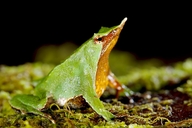Rhinodermatidae |
3 species in 2 genera
Commonly Called Mouth-brooding Frogs, Darwin's Frogs

Rhinoderma darwinii
Photo by Bert Willaert
(Click for family gallery)Members of this family would be included within the Cycloramphidae if it were not for their strange modes of brooding their offspring. The eggs are laid on land and the tadpoles are carried to water in the mouth of the male (Rhinoderma rufum) or complete their development within the vocal sacs of the male (Rhinoderma darwinii). In the case of Rhinoderma darwinii, the larvae receive nutrition from viscous secretions within the male's vocal pouch, remaining within the pouch until they become froglets and emerge from the male's mouth. The etymology of their generic and familial name means "rhinoceros-nosed" referring to the proboscis-like extension that is present at the tip of the snout.
All members of this family are listed by IUCN as Vulnerable or Critically Endangered.
Written by AmphibiaWebNotable Family Characteristics
- Terrestrial
- Occurs in temperate wet forests and riparian corridors
- Proboscis-like extension at the tip of the snout is present lending its family and generic name Rhinoderma
- Egg-layers with parental care, including the extreme form of brooding and feeding wthin the vocal sacs of male Rhinoderma darwinii
- Distribution limited to southwestern Argentina and Chile in South America

Cartography Credit: Zoe Yoo, UC Berkeley
Range maps sources: AmphibiaWeb, UC Berkeley, and IUCN RedListRelevant Reference
Pough, F. H., R. M. Andrews, M. L. Crump, A. H. Savitzky, K. D. Wells, and M. C. Brandley. 2015. Herpetology. Fourth Edition. Massachusetts: Sinauer.
Vitt, L. J., and J. P. Caldwell. 2013. Herpetology. An Introductory Biology of Amphibians and Reptiles. Fourth Edition. Amsterdam: Elsevier.
Genus Insuetophrynus (1 species)
Insuetophrynus acarpicus account no photos no sound/video
Genus Rhinoderma (2 species)
Rhinoderma darwinii account photos no sound/video Rhinoderma rufum account no photos no sound/video
Citation: AmphibiaWeb: Information on amphibian biology and conservation. [web application]. Berkeley, California: AmphibiaWeb. Available: https://amphibiaweb.org/. (Accessed:
AmphibiaWeb's policy on data use.
